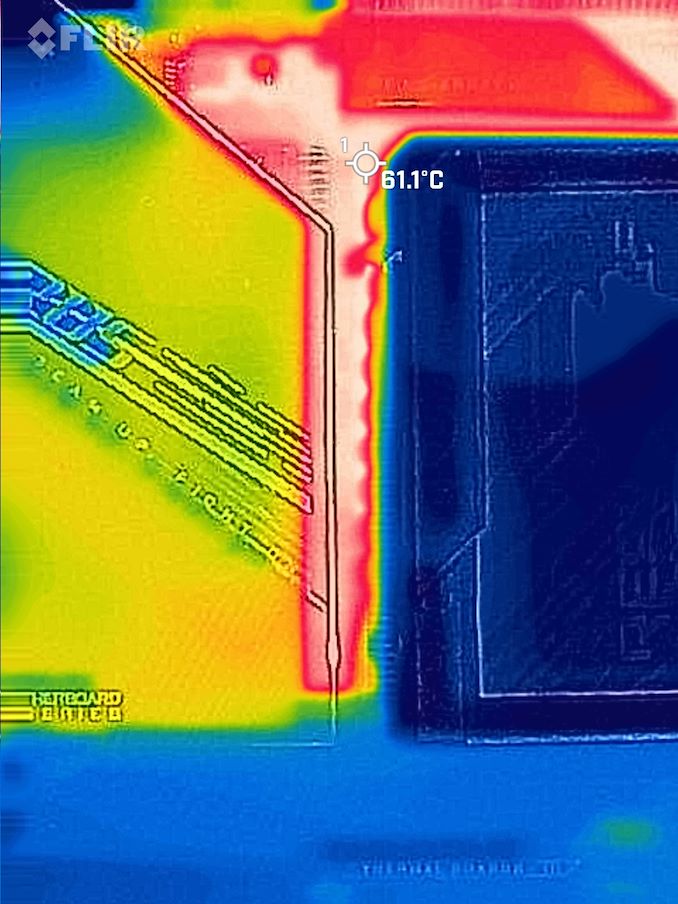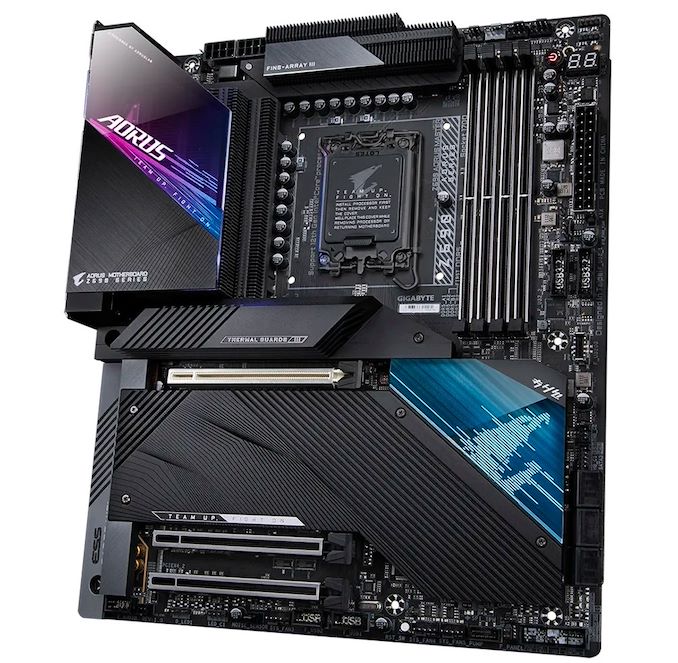The GIGABYTE Z690 Aorus Master Mobo Review: 10GbE Rounds Out A Premium Board
by Gavin Bonshor on February 25, 2022 9:00 AM EST_678x452.jpg)
The latest motherboard to grace our test bench is the GIGABYTE Z690 Aorus Master, which hails from its Aorus gaming series and sits just one step below its Aorus Xtreme models. Some of its most notable features include 10 Gigabit Ethernet and Wi-FI 6E networking, USB 3.2 G2x2 connectivity, as well as plenty of storage capacity consisting of five M.2 slots and six SATA ports. The Aorus Z690 Master also boasts support for DDR5-6400 memory and an impressive 20-phase power delivery designed for overclockers looking to squeeze out extra performance. Does the GIGABYTE Z690 Aorus have enough about it to justify the $470 price tag? We aim to find out in our latest Z690 motherboard review.
Across GIGABYTE's many different series of motherboards for Z690, including the Aorus for enthusiasts and gaming, the Gaming series for gamers on a tighter budget, the Aero for content creators, and the UD (Ultra Durable) series for the entry-level. GIGABYTE, in general, has a good degree of separation for its product ranges, which makes it easier for consumers to distinguish between each of its models from the pretty large stack of Z690 models it has. Each of its different series occupies a different price point and comes equipped with a varying level of features.
GIGABYTE Z690 Aorus Master Overview
Focusing on the GIGABYTE Z690 Aorus Master motherboard, it's the most premium of the company's Z690 models, save its flagship Xtreme series duo, the Z690 Aorus Xtreme, and the water block inclusive Z690 Aorus Xtreme WaterForce. As the Master series is a premium model, it's equipped with an equally premium-looking aesthetic, with waves of black heatsinks covering the all-black PCB, as well as multiple areas of integrated RGB LED lighting. It has a typical Aorus theme throughout, which hasn't changed all that much over the last couple of years.
The GIGABYTE Z690 Aorus Master has lots to offer users looking for a high-end Z690 motherboard, including support for the latest DDR5 memory. This includes speeds of up to DDR5-6400 supported out of the box, including 128GB across four memory slots. Storage support is also equally impressive, with support for up to five M.2 slots (four PCIe 4.0 x4 and one PCIe 3.0 x4), as well as six SATA ports that are capable of installing RAID 0, 1, 5, and 10 arrays. Despite its premium design, GIGABYTE includes just one full-length PCIe 5.0 x16 slot, with two full-length PCIe 3.0 x4 slots, instead of offering the capability for PCIe 5.0 x8/x8.
GIGABYTE also uses the Z690 chipset's native support in other ways, including support for two USB 3.2 G2x2 Type-C ports (one rear panel, one header), as well as a total of eleven USB ports on the rear panel (two Type-C, nine Type-A) which is perfect for users with lots of USB devices. Also featured is a quality networking array, including a single 10 Gigabit Ethernet controller, along with an Intel Wi-Fi 6E CNVI that supports both the 6 GHz band and BT 5.2 devices. The onboard audio solution also consists of a premium Realtek HD audio codec and ESS DAC chip, and a single DisplayPort 1.2 video output for users planning to use Intel's integrated Xe Iris graphics.
Designed with performance in mind, GIGABYTE advertises a large 20-phase power delivery split into a 19-phase direct design for the CPU with 105 A power stages and a single-phase 70 A power stage designated for the SoC. This is more than enough for overclocking Alder Lake to its limits, with the Aorus Master being designed to offer enthusiast-level performance combined with its Aorus 'gaming' features.

The GIGABYTE Z690 Aorus Master undergoing our VRM thermal testing
Quickly analyzing the raw performance of the GIGABYTE Z690 Aorus Master, it showed its competitiveness against other Z690 models in all three of our primary testing areas, including system, compute, and gaming performance. In our overclock testing, the Z690 Aorus Master displayed true character with very tight VDroop control on the CPU VCore voltage at full-load, and it was equally impressive in our VRM thermal testing.
The GIGABYTE Z690 Aorus Master has an MSRP of $470, and at the time of writing, it is available at Newegg for this price. As it stands, there's some competition at the price point, including the ASRock Z690 PG Veloctia ($470), the ASUS ROG Strix Z690-E Gaming WIFI ($470), and the MSI MEG Z690 Unify ($490), with each of them all deserving of merit in their own way. The advantage that GIGABYTE has over the models above is that it includes 10 GbE, which is a feature that's typically reserved for the (very expensive) flagship Z690 boards. With its impressive array of features, capability, and premium design, the GIGABYTE Z690 Aorus Master ticks many boxes for under $500, but can it walk the walk? That's the biggest question that we intend on answering in this review.
Read on for our extended analysis.











35 Comments
View All Comments
Silver5urfer - Saturday, February 26, 2022 - link
You should have gone with MSI Unify X or ASUS APEX series for DRAM performance. Tachyon was not good for Z590 not sure how it is for Z690.meacupla - Friday, February 25, 2022 - link
Were you able to get memory to overclock beyond its stock 4800?The board's spec does say it supports up to 6400.
Because I have doubts that this board can really do 6400, when it has 4 slots.
Jp7188 - Sunday, February 27, 2022 - link
It would be great if Anandtech would do a piece comparing memory overclocks on the various boards. I was super excited to get my hands on a 6400 CL32 kit only to find it wouldn't work at full speed in the Aorus Master while it apparently does in other boards from ASUS and MSI. Fast mem with tight timings appears to be a significant differentiator for this generation of motherboards.Infy2 - Sunday, February 27, 2022 - link
Testing 2022 hardware with graphics card from 2016, time to upgrade I think? A powerful CPU like Adler Lake with such an obsolete graphics card will hardly show meaningful differences in gaming performance.shabby - Monday, February 28, 2022 - link
Insert AnandTech gpu review joke here...DanNeely - Monday, February 28, 2022 - link
The only way you're going to see any differences from CPU performance is to turn the graphics settings down to the point where the GPU isn't fully loaded and the CPU itself becomes the bottleneck. At that point any vaguely half decent card will work.Tom Sunday - Sunday, February 27, 2022 - link
Yes the GIGABYTE Z690 Aorus Master is pricey to say the least. I like to think being an enthusiast myself, but at the same time not convinced that l will be able to really taking proper advantage of all the Z690 Aorus Master offered premium features. It’s almost March/April now knocking on our door and I wonder with Intel breaking-out in the second half of 2022 their next-gen 13th Gen Core Raptor Lake, is it actually time to hold off building or even thinking now about an all new premium ($$$$) system? Intel proffers in featuring double-digit performance increases and greater core and thread counts. Moreover a more matured Alder Lake tech! Motherboard vendors in turn already doing a similar marketing dance of much improved MB-tech over their fall 2021 or early 2022 premium products. The old story prevails! “When to hold and when to fold with ones dollars?TLindgren - Monday, February 28, 2022 - link
Yeah, it's expensive but the real problem this motherboard have is that Gigabyte has a cheaper motherboard that is arguably better in many ways, the Z690 Aero D! The Master does have better integrated Audio though - the Aero D's ALC4080 is just as good as the Master's ALC1220 but they skimped on audio connectors so the Aero D is only 2.0, not 7.1.Differences:
* Aero D offers both x16/x0 or x8/x8 PCIe 5.0 vs the Masters x16 PCIe 5.0 plus PCIe 4.0 4x!. Both have a third x16 running in x4 PCI 3.0.
* Both have the same 10Gbps network chip, Aero D adds a 2.5Gbps to that.
* Aero D adds dual Thunderbolt (replaces the "plain" USB-C connectors)
* Aero D had DP+HDMI for the iGPU, Master has just DP - these outputs are useful for debugging and adding more screens while still rendering on the dGPU. With TB the Aero D has potentially four extra screens while Master has one!
* Audio is a clear win for the Master - the audio codec on the Aero D should be comparable to the one used on the Master, but it doesn't have ports in the back for more than 2.0 audio!
* Master has 5 M.2 compared to Aero D's 4.
* Master has 9 USB Type-A compared to Aero D's 6.
* Master has... "voltage measurement points". Swoon (not!).
I consider the extras the Aero D has to be far more consequential than the extras the Master has, *except* Audio.
The four PCIe 5.0 switches in the Aero D should cost Gigabyte more than the improved Audio on the Master and that ignores that Aero D also have 2xThunderbolt and a second LAN controller.
So, exactly why does the Master cost $499?
The answer is of course that retail pricing is controlled by what they think they can take for it, not what it costs to make, as long as they're not loosing money of course.
DanNeely - Monday, February 28, 2022 - link
With garbage 2.0 audio out the Areo D belongs in the $20 or less liquidation junkbin if not the dumpster out back.nevcairiel - Monday, February 28, 2022 - link
I haven't used analog audio connectors in years. Headphones run a USB DAC, desktop speakers are just stereo, and actual movie watching uses HDMI to a receiver.Gladly safe a whole bunch of money if audio is the only meaningful difference I don't care about. Not that I'm going to buy anything Gigabyte anyway..